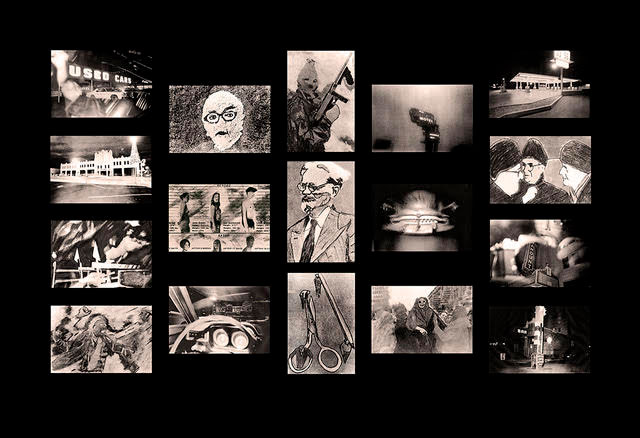|
|
|
 |
 |
 |
 |

Underground City 1978

The Underground City is a photo-based psychological interpretation of America's cultural climate after the end of the Vietnam War. The project includes two distinct bodies of work. One depicts atmospheric nighttime settings of physical places with exaggerated light and shadow effects with the addition in some works of applied color. Photographed in darkness with direct, glaring flash in Hollis Queens, New York (home of Hip-Hop) and Amarillo Texas in 1970s when urban centers across the United States were experiencing a decline as the post-World War II economic boom began to wane due to the expense of the Vietnam War. Furthermore, increased international competition resulted in the decline of manufacturing jobs. America's automobile culture was shocked by an OPEC oil embargo, which led to an energy crisis, a rise in unemployment, and stagflation. The high-contrast images, which intentionally suppress photographic detail, convey the raw, stressful signs of decay and social alienation of a slow-motion existential crisis that exposed a lack of economic opportunity and social justice. These caustic forces bred an in-between sense of powerlessness, meaninglessness, and psychological isolation. This series of photographs drive the notion that the law of the day is not the same as that of the night.
In contrast to the austere social landscapes, the subsequent part of this body of work consists of unidentified, yet often recognizable newspaper half-tones from that period that were hand-altered, rephotographed, printed on a graphic arts paper, and toned. These embellished images introduce humans into the equation and generate a sequence of disconcerting juxtapositions. The superficial randomness of these enigmatic combinations delivers unexpected connections, meanings, and emotional reactions by interspersing these culturally estranged works in a salon-style wall installation. This idiosyncratic presentation allows a polyglot of images to indirectly approach the difficult to define sensation of self-estrangement in an ambiguous, unfamiliar, and tumultuous environment with the potential of finding new direction.
As a pictorial group, this combined expressionist approach challenges conventional notions of detail-oriented documentary photography in which the subject matter is clearly related and resolved. These works offer an invitation to suspend objectivity and enter the private theater of the mind. Here one is welcome to examine a subject beyond its external physical structure and look inside the heart of an experience. The difficulty lies in trying to transpose the night into the day, which has no knowledge of the latter. This project tackles this challenge by advocating for the exploration of the intuitive world of the "thing in itself" by creating a space to examine the multi-layered structure of cultural, political, and psychological models that determines how we form our worldview. It is here where the ordinary rules of narration are suspended and one has the freedom to experience the images as entities themselves without the anchor of past rationalizations.
These images were made by Hirsch after joining the Amarillo College photography faculty in 1976 and exhibited at the Amarillo Art Center, now the Amarillo Museum of Art, in 1978.
Underground City 1978
|
|
 |
 |
 |
 |
|
|
|